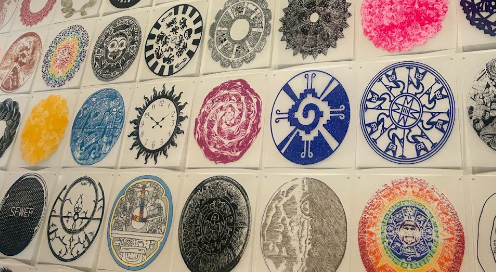
From Feb. 17 to June 9, the Wellin Museum will be exhibiting René Treviño’s “Stab of Guilt.” Alexander Jarman led the curation of this exhibition, marking his first time as lead curator at the Wellin. Throughout the curation process, Jarman worked very closely with Treviño to select and display over 200 artworks. Due to their close relationship and Treviño’s passion for teaching, the artist returned to campus for a week of classroom visits and discussions on his exhibit.
René Treviño’s bright aesthetic is noticed immediately upon entering “Stab of Guilt.” The entrance is confronted with a larger-than-life black and gold stage preset with courtly robes embellished with faux jaguar fur and patches. This installation combines Treviño’s background in theatre, while placing Mexican and Western history in conversation with one another. By placing such a theatrical piece at the entrance, Treviño and Jarman are playing into the artist’s favorite component of theatrical spaces: “that you walk in and are ready to suspend your disbelief.” This installation successfully set the tone and expectation for this beautiful but complex exhibition.
“Stab of Guilt” is a multidisciplinary exhibition that encompasses a wide range of mediums and inspirations. Treviño created elaborate costuming, intricate star maps, a planetarium, and much more for this display. Throughout most of his work, the artist explores Mayan and Aztec history, Catholic symbolism, astronomy, pop, culture, and queer theory to represent his identity and heritage in a new way. For Treviño, artists are the only ones who can thoroughly challenge and reconstruct history under a modern lens.
As Treviño covers highly complex topics with deeply intricate and time-consuming artworks, it may seem like he has been an artist his whole life. However, “growing up in rural south Texas, [René] never even saw artists or that [he] could live [his] life that way.” As seen in many of his artworks, Treviño went to undergrad for Theatre at Texas A&M and it wasn’t until he went to New York City that he realized that he could become an artist. Once he dedicated himself to his art and after a trip to his ancestral home of Mexico City, Treviño began to focus on creating art that represented his identities and the arduous labor his ancestors put in before him. All of the art on display in “Stab of Guilt” can be connected to Treviño’s past and this commitment to himself.
In an interesting conversion of past and present, Treviño manipulated nineteenth-century star charts made by C.H.F. Peters (Hamilton College’s first professor of astronomy). Three years ago, when Treviño first began working with the Wellin he was invited to look into the archives. It was there he found the celestial charts that were then photocopied to create “Sunspots by Day, Asteroids by Night” (2023). In this series Treviño paints on and attaches colorful, sparkly 3D objects to those nineteenth-century celestial charts. This is one of the many artworks from “Stab of Guilt” in which Treviño merges historically Western views of the heavens with Mayan and Aztec perspectives. Not only that, but the bright colors and use of glitter illuminate the artist’s queer identity and culture.

Over the three years Treviño was visiting campus to complete his exhibition, he was able to explore various departments and was given access to their resources. Through this he interacted with students, faculty, and staff. By way of these interactions, Treviño became “so psyched about [Hamilton College]” and felt “incredibly fortunate to be asked to display [his] work here.” It was incredibly moving to hear how highly Treviño spoke about Hamilton College and the Wellin Museum. It was clear that without Alexander Jarman or Hamilton College this exhibition would look incredibly different.
René Treviño is an incredibly talented artist who is willing to put in the tedious labor to complete complex artwork that are inspired by his hardworking ancestors. Stab of Guilt is an extension of this commitment. Though Treviño only worked with the Wellin for three years, some of the pieces in this exhibition go back as early as 2008. To see over a decade of Renè’s work and leave with a nuanced understanding of history, visit the Wellin Museum before June 9.
















